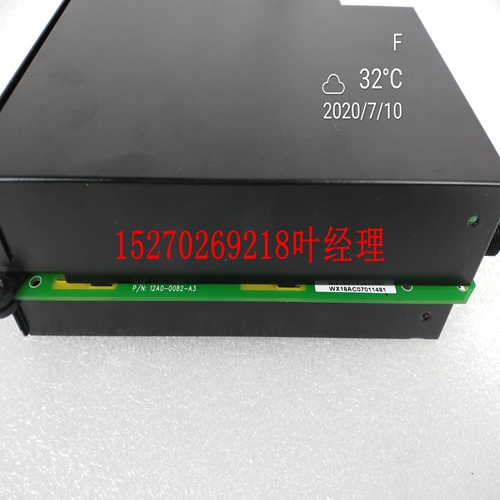IS200BAIAH1BEE工业自动化卡件
逻辑或算法。469块启动功能始终分配给块启动继电器。除跳闸继电器外,跳闸将始终操作块启动继电器。如果导致跳闸的条件仍然存在(例如热RTD),或者按下重置键时存在锁定时间,则在该条件不再存在或锁定时间到期之前,块启动继电器不会重置。当导致闭塞的条件停止时,所有闭塞功能始终解锁并立即复位。除了在跳闸时激活外,一旦电机停止,块也可能激活。有几个功能可以这样操作:启动/小时、启动间隔时间、启动抑制、重启块和469未编程。当一个块变为活动时,更新块消息以反映该块(如果需要,完成锁定时间),屏幕默认为该消息。块通常不作为事件记录。但是,如果在块激活时检测到电机启动或启动尝试,则会自动记录为日期和时间戳事件。如果有人在接线端子之间短路并超越469保护以启动电机,则可能会出现这种情况。4-2 469电机管理继电器GE Power Management 4.1概述4设定点编程4 4.1.2继电器分配实践有六个输出继电器。其中五个继电器始终是非故障安全的,另一个(服务)是故障安全的并专用于阐明内部469个故障(这些故障包括设定点损坏、硬件组件故障、控制电源损失等)。其中一个输出继电器专用于块启动继电器;它专门用于阻止电机启动的功能。其余四个继电器可根据需要针对不同类型的功能进行编程。其中一个继电器R1 TRIP拟用作主跳闸继电器。另一个继电器R4 ALARM拟用作主报警继电器。剩下的两个继电器R2辅助和R3辅助用于特殊要求。当将特征分配给R2和R3时,最好尽早决定需要什么,因为可能分配的特征可能会冲突。例如,如果R2 AUXILIARY用于上游跳闸,则不能用于控制降压启动。类似地,如果R3专用于继电器,以将所有报警条件反馈给PLC,则它也不能严格用于发出特定报警,如欠电流。为了确保中继分配中不发生冲突,已采取了若干预防措施。除短路备用跳闸外,所有跳闸默认为R1跳闸输出继电器。所有报警默认为R4报警继电器。只有特殊控制功能默认为R2和R3辅助继电器。建议在所有设定点编程完成后,对这些分配进行审查。GE Power密码a)功能除设置点访问跳线外,还提供密码访问安全功能。出厂时,密码默认为0。当密码为0时,将忽略密码保护。在这种情况下,只需要设置点访问跳线即可从前面板更改设置点。通过RS485端口编程设定点时,密码也会被忽略。但是,使用前RS232端口和469PC软件编程设定点,需要密码(如果启用)。b) 启用密码保护要在新继电器上启用密码保护,请按直到显示。选择“Yes”(是)并按照指示输入1-8位数字的新密码。一旦编程了除0以外的密码,则必须在每次限制设置点访问时输入密码。如果编程了非零密码,并且限制了设置点访问,则在输入密码子组时会出现以下消息:输入正确的密码。如果代码不正确,将显示一条闪烁消息,并允许重试。
logic or algorithm. An 469 Block Start feature is always assigned to the Block Start relay. In addition to the Trip relay(s), a trip will always operate Block Start relay. If the condition that has caused the trip is still present (e.g. hot RTD), or there is a lockout time when the Reset key is pressed, the Block Start relay will not reset until the condition is no longer present or the lockout time has expired. All blocking features are always unlatched and reset immediately when conditions that caused the block cease. In addition to becoming active in conjunction with trips, a block may become active once the motor stops. There are several features that operate as such: Starts/Hour, Time Between Starts, Start Inhibit, Restart Block, and 469 Not Programmed. When a block becomes active, the block messages are updated to reflect the block (complete with lockout time if required) and the screen defaults to that message. Blocks are normally not logged as events. If however, a motor start or start attempt is detected when a block is active, it is automatically logged as a date and time stamped event. This scenario might occur if someone shorts across the block terminals and overrides the 469 protection to start the motor. 4-2 469 Motor Management Relay GE Power Management 4.1 OVERVIEW 4 SETPOINT PROGRAMMING 4 4.1.2 RELAY ASSIGNMENT PRACTICES There are six output relays. Five of the relays are always non-failsafe, the other (Service) is failsafe and dedicated to enunciate internal 469 faults (these faults include Setpoint Corruption, failed hardware components, loss of control power, etc.). One of the output relays is dedicated as the Block Start relay; it is dedicated to features that are intended to block motor starting. The four remaining relays may be programmed for different types of features depending on what is required. One of the relays, R1 TRIP, is intended to be used as the main trip relay. Another relay, R4 ALARM, is intended to be used as the main alarm relay. The two relays that are left, R2 AUXILIARY and R3 AUXILIARY, are intended for special requirements. When assigning features to R2 and R3, it is a good idea to decide early on what is required since features that may be assigned may conflict. For example, if R2 AUXILIARY is to be used for upstream trips, it cannot also be used for the control of a Reduced Voltage Start. Similarly, if R3 is to be dedicated as a relay to echo all alarm conditions to a PLC, it cannot also be used strictly to enunciate a specific alarm such as Undercurrent. In order to ensure that conflicts in relay assignment do not occur, several precautions have been taken. All trips with the exception of the Short Circuit Backup Trip default to R1 TRIP output relay. All alarms default to the R4 ALARM relay. Only special control functions are defaulted to the R2 and R3 AUXILIARY relays. It is recommended that these assignments be reviewed once all the setpoints have been programmed. GE Power PASSCODE a) FUNCTION A passcode access security feature is provided in addition to the setpoint access jumper. When shipped from the factory, the passcode is defaulted to 0. Passcode protection is ignored when the passcode is 0. In this case, only the setpoint access jumper is required for changing setpoints from the front panel. Passcodes are also ignored when programming setpoints via the RS485 port. However when programming setpoints using the front RS232 port and the 469PC software, a passcode is required (if enabled). b) ENABLING PASSCODE PROTECTION To enable passcode protection on a new relay, press then until is displayed. Select "Yes" and follow directions to enter a new passcode from 1-8 digits. Once a passcode other than 0 is programmed, it must be entered each time setpoint access is restricted. If a non-zero passcode has been programmed and setpoint access is restricted, then the following message appears when entering the PASSCODE subgroup: Enter the correct passcode. A flash message will advise if the code is incorrect and allows a retry.













